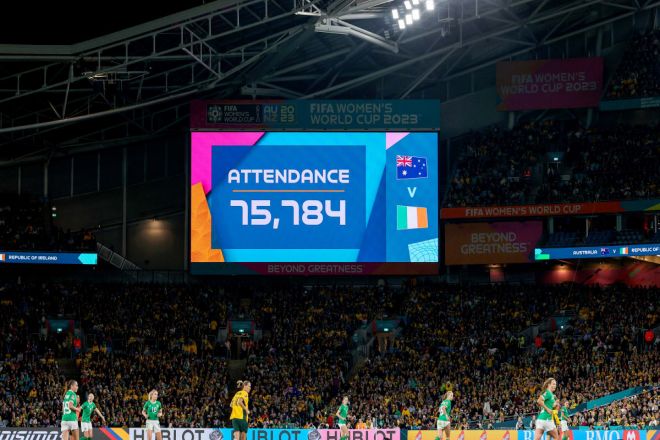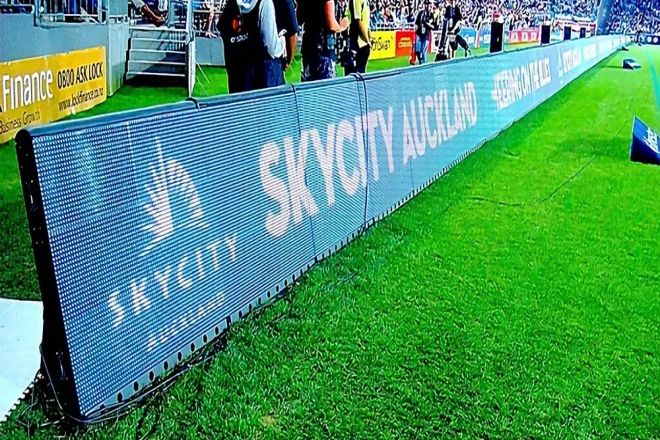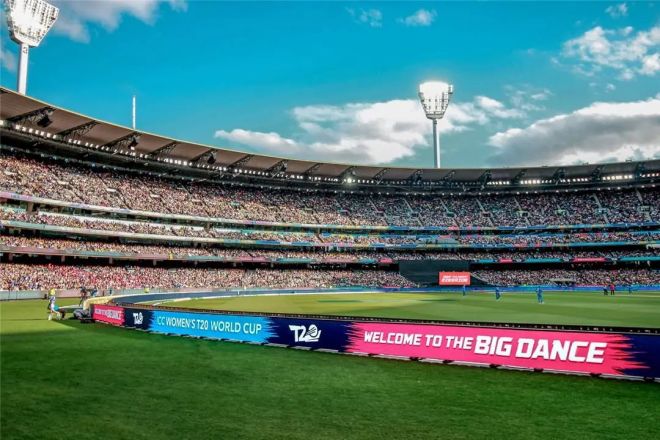Introduction

As one of the most influential and spectacular sports events in the world, the World Cup is not only a stage for players to compete in skills but also a feast for fans to enthusiastically celebrate. At this stage, Affichage LED, with its unique technical advantages and wide application scenarios, has become an important tool to help the World Cup show its unique charm.
From the display of real-time scores and event information to the enrichment of audience interaction and entertainment experience to the creation of venue lighting and atmosphere, LED display, with its outstanding expressiveness and innovative application, has added countless brilliance to the successful hosting of the World Cup and the fans’ viewing experience.
1. Application of LED display in the World Cup

- Real-time score and event information display
During the World Cup, the LED display became the core tool for delivering game information. These display screens are spread around the stadium and inside the stadium. They not only update the scores of the game in real-time to ensure that fans are always aware of the latest game situation but also display key information such as the progress of the game, player list, statistics, etc.
Through these detailed information displays, fans can have a deeper understanding of the game and enhance the sense of participation and immersion in watching the game.
- Audience interaction and entertainment experience
The LED display also plays an important role in enhancing audience interaction and entertainment experience. Through the display screen, the organizer can display the audience’s interactive content, such as real-time voting, lottery, etc. These interactive links not only increase the fun of the game but also allow the audience to participate more deeply in the game.
In addition, the LED display screen can also play advertisements, entertainment programs, etc., to provide fans with rich and colorful entertainment content during the intervals between watching the game, further enhancing their viewing experience.
- Stadium lighting and atmosphere creation
In addition to information display and entertainment functions, LED display screens also bear the heavy responsibility of creating stadium lighting and atmosphere. As part of the stadium lighting, LED display screens can provide uniform and soft light sources to ensure that every corner of the stadium can be illuminated.
At the same time, by adjusting the color and brightness of the display screen, the organizer can create an exciting game atmosphere and bring a more shocking audio-visual experience to the players and the audience. At critical moments of the game, such as goals and penalties, the LED display screen can instantly change color and brightness, bringing a strong visual impact and emotional resonance to the audience.
2. The role of LED display screens in the dissemination and promotion of the World Cup
- Expanding the influence of the event
LED display screens play a vital role in the dissemination of the World Cup. They are a key tool to expand the influence of the event. By setting up and arranging LED screens around the world, the wonderful moments and highlights of the World Cup can be displayed to the audience in real-time, thus attracting more people’s attention and interest.
Whether it is the streets and alleys of the city or public places such as shopping malls and stations, LED screens can convey the passion and charm of the World Cup to every passerby, allowing more people to feel the charm of football and the grand occasion of the World Cup.
- Promoting brands and commercial cooperation
LED screens are also an important carrier for the commercial promotion of the World Cup. During the event, major sponsors used LED screens to display their brand image and product information to increase brand exposure and visibility.
At the same time, LED screens have also become a platform for displaying commercial cooperation information, promoting the deep integration of World Cup events and commercial activities by playing commercial advertisements, partner logos, etc.
This cooperation not only brings rich returns to sponsors but also injects more commercial vitality and innovative elements into the World Cup.
- Spreading football culture and values
In addition to commercial promotion, LED screens also undertake the important mission of spreading football culture and values.
By playing football-related promotional videos and documentaries, LED screens popularize football knowledge, introduce football history and cultural background to the audience, and let the audience have a deeper understanding of the connotation and charm of the sport of football.
At the same time, LED display screens also convey the values of unity, hard work, and progress represented by football. These values not only inspire players to fight hard on the field but also inspire the audience to pursue excellence and keep making progress in life and work.
3. What conditions must the LED display screen meet for sports events?

As an LED display screen for sports events, in order to ensure the smooth progress of the event and bring the best viewing experience to the audience, the following conditions must be met:
1). High brightness and visibility:
Sports venues usually face strong outdoor light conditions, so LED display screens need to have high brightness to ensure that they can still be clearly visible under strong light. Brightness usually needs to meet relevant standards.
For example, for outdoor LED display screens, the brightness requirements may be between thousands and tens of thousands of nits (cd/m²).
2). Large size and resolution:
Des sports venues require large-size display screens to cover the audience area and provide high-resolution images and videos to ensure that the audience can see details and real-time game conditions.
Large size means a larger viewing range and high resolution ensures image clarity and detailed display.
- Temps de réponse rapide :
Sports games and performances often require fast image switching and updating, so LED displays need to have fast response times to avoid image blur or tearing. Response times are usually measured in milliseconds (ms), and fast responses ensure smooth images.
- High contrast and vivid colors:
Good contrast and vivid colors can enhance the layering and visual effects of images, allowing viewers to better experience games and performances. Displays with high contrast can show richer light and dark details, and vivid colors make the picture more vivid.
- Étanche à la poussière et à l'eau :
Sports stadium environments may be affected by weather and environment, so LED displays need to have certain dustproof and waterproof capabilities to ensure the stability and durability of the equipment. Waterproof and dustproof levels are key indicators for evaluating this capability.
- Reliability and stability:
Sports stadium activities often attract large audiences, so LED displays need to have high reliability and stability to avoid failures at critical moments. This includes the use of high-quality materials, reasonable structural design, and reliable power supply and control systems.
- Remote control and monitoring:
Sports stadium LED displays often need to be able to be remotely controlled and monitored so that they can be adjusted and managed when needed. This includes control of brightness, color, content playback, and real-time device status monitoring.
3). Audience distance considerations:
The distance of the audience inside the stadium may vary, so the pixel density and size of the display need to be reasonably selected according to the different audience distances to ensure that the audience can get a clear image at different positions. This requires an in-depth understanding of the layout of the venue and the distribution of the audience.
4). Energy saving and environmental protection:
Large LED display screens that run for a long time need to consider energy saving and environmental protection factors to reduce energy consumption and environmental impact. This includes the use of efficient LED chips, energy-saving drive circuits, and reasonable heat dissipation design.
5). Safety and reliability requirements:
The material selection of LED display screens should consider the use of polymer materials with good flame retardant properties, and the power supply design should comply with relevant standards, including separate power supply and overload protection functions. At the same time, the LED display screen should have functions such as smoke detection, lightning protection, automatic fire alarm, and automatic screen shutdown to ensure safety in emergency situations.
Conclusion
Looking back, the wide application and outstanding performance of LED display screens in World Cup events have given us a deeper understanding of the power of science and technology and the charm of innovation.
Looking into the future, with the continuous advancement of technology and the continuous expansion of application scenarios, LED displays will demonstrate their unique value and role in more fields.
Enfin, si vous souhaitez en savoir plus sur les écrans LED, veuillez nous contacter.
